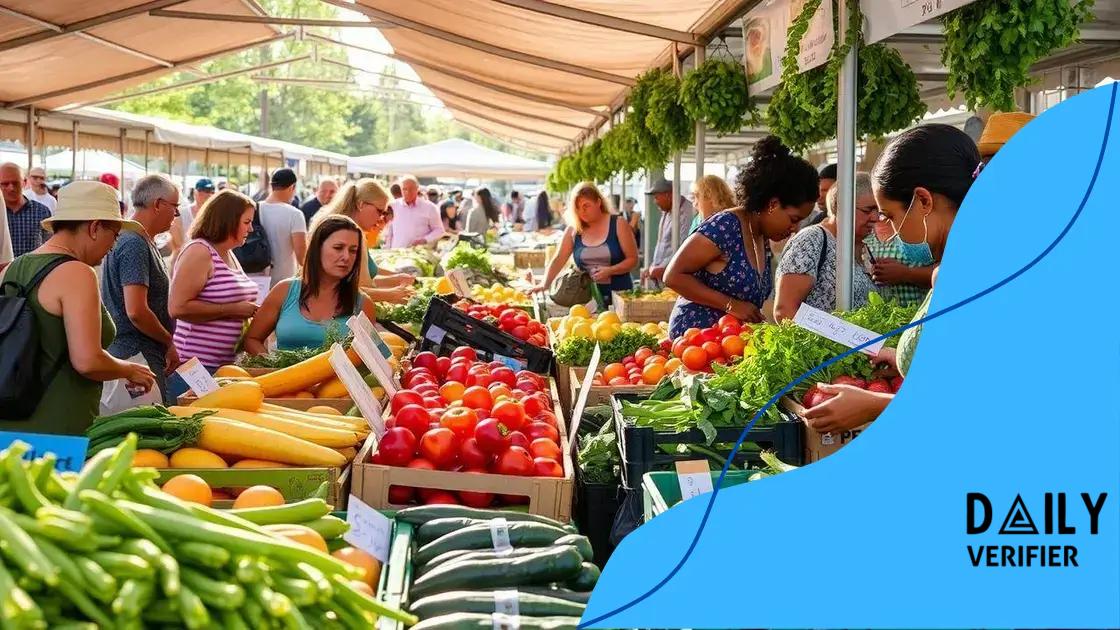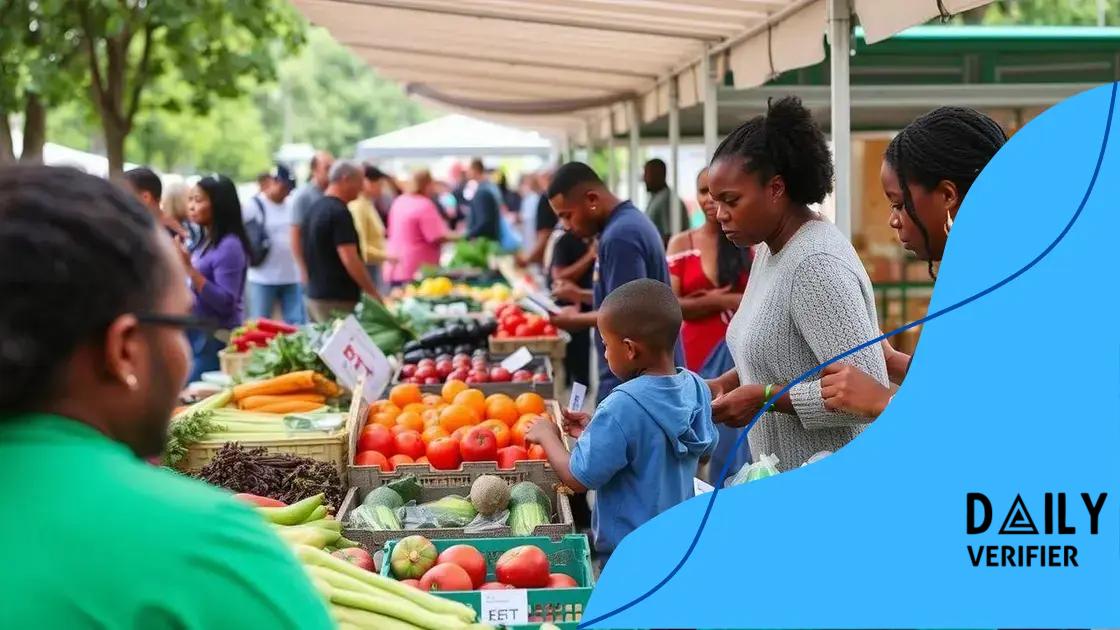SNAP covers farmers’ markets: A guide to local produce

SNAP covers farmers’ markets, allowing low-income families to access fresh produce while supporting local farmers and improving community health.
SNAP covers farmers’ markets, making it easier for families to access fresh, local produce. Have you ever wondered how this program helps your community thrive? Join us as we explore its benefits and impact.
Understanding SNAP and its importance
Understanding SNAP is essential for grasping its impact on farmers’ markets and local communities. The Supplemental Nutrition Assistance Program helps families access nutritious food, especially during tough economic times.
The importance of SNAP goes beyond just feeding individuals; it supports local economies and encourages healthy eating habits. Let’s take a closer look at how SNAP operates.
How SNAP Benefits Farmers’ Markets
SNAP enables low-income individuals to purchase food directly from local farmers. This connection strengthens the relationship between consumers and producers.
- Boosts local economic activity.
- Increases sales for small farmers.
- Enhances community well-being.
Moreover, SNAP transactions at farmers’ markets typically involve electronic benefit transfer (EBT) cards. This innovation makes it easy for recipients to pay for their groceries while ensuring that farmers receive fair compensation for their goods.
Additionally, many markets offer incentives for using SNAP. These incentives can double the value of benefits spent, making fresh produce even more affordable for consumers.
The Reach of SNAP
SNAP is not just limited to urban areas; it plays a crucial role in rural communities as well. Farmers’ markets situated in rural zones often see a high participation rate among SNAP users.
By making local and healthy food more accessible, SNAP helps combat food insecurity and promotes healthier lifestyles. It’s clear that the program provides a lifeline to many families, encouraging them to prioritize their health and well-being.
As we continue to explore SNAP, the benefits it brings to farmers’ markets are evident. By understanding this program, we can appreciate its role in supporting communities and ensuring that everyone has access to healthy food options.
How SNAP works at farmers’ markets
Understanding how SNAP operates at farmers’ markets is key to maximizing its benefits for consumers. SNAP, or the Supplemental Nutrition Assistance Program, allows eligible participants to purchase food using an Electronic Benefit Transfer (EBT) card, making it easier to access fresh produce.
When first introducing this program at farmers’ markets, many vendors must adjust to a new payment system. However, by implementing EBT terminals, they can accept SNAP benefits, which leads to increased sales and more customers.
How EBT Works
To use SNAP benefits, customers visit the farmers’ market and swipe their EBT card at a designated area.
- The farmer or vendor checks the available balance on the card.
- After approval, the customer selects their products.
- The vendor processes the transaction electronically.
This setup not only facilitates easier purchases for low-income families but also fosters community support for local farmers. As more customers use their SNAP benefits at farmers’ markets, it creates a thriving environment for local food producers.
Incentives and Programs
Many farmers’ markets enhance the SNAP experience by offering various incentives. For example, some markets provide matching programs where every dollar spent with SNAP can be doubled, allowing families to buy even more healthy food.
This approach strengthens the connection between consumers and local agriculture while encouraging healthier dietary choices. Families benefit by getting more for their money and supporting local businesses at the same time.
Understanding how SNAP works at farmers’ markets highlights its essential role in promoting community health and well-being, while also benefiting local economies.
Benefits of using SNAP for farmers

The benefits of using SNAP for farmers are numerous and significant. As more individuals utilize this program, farmers can expand their customer base and increase sales. This creates a healthier, more robust community and economy.
Better access to fresh produce is one of the key advantages. When local farmers accept SNAP, it encourages low-income families to buy healthier options, which can improve their overall nutrition and well-being.
Economic Growth
SNAP participation leads to substantial economic growth in the community.
- Farmers experience increased revenue from SNAP transactions.
- Local economies thrive when residents spend their benefits in the area.
- More customers mean more opportunities for farmers to grow and diversify their offerings.
This economic boost helps keep farms sustainable and supports the livelihoods of local farmers.
Community Engagement
Another vital benefit of SNAP is increased community engagement at farmers’ markets. When customers can use their EBT cards, they feel encouraged to participate more actively in local markets.
As a result, community ties strengthen, leading to a richer market environment where vendors and customers alike build lasting relationships.
Through SNAP, farmers gain not just customers but also advocates for their products and practices, fostering a supportive network that benefits everyone involved.
By understanding the various advantages that SNAP offers farmers, stakeholders can better appreciate how this program plays a crucial role in supporting local agriculture and community health.
Engaging with local farmers and vendors
Engaging with local farmers and vendors is a vital aspect of utilizing SNAP benefits at farmers’ markets. This interaction helps foster a sense of community, which in turn supports local economies.
When people shop at farmers’ markets, they are not just buying food; they are connecting with the people who grow it. Building relationships with farmers enhances the shopping experience, making it feel more personal and meaningful.
The Importance of Relationships
As customers engage with vendors, they learn about the food’s origins, farming practices, and seasonal availability.
- This knowledge encourages healthier eating habits.
- Direct connections can lead to loyalty and repeat business.
- Farmers appreciate feedback, which helps them improve their products.
Moreover, farmers benefit from this engagement by understanding the needs and preferences of their customers. This feedback allows them to adjust their offerings and better cater to the community.
Community Activities and Events
Many farmers’ markets host events that encourage further interaction. These can include cooking demonstrations, seasonal festivals, or even workshops on sustainable farming practices.
Such activities not only draw in larger crowds but also create an educational atmosphere where attendees gain valuable insights into nutrition and farming techniques. Engaging in these events can make shopping at farmers’ markets more enjoyable and meaningful.
When consumers actively engage with local farmers and vendors, they help support a sustainable food system while promoting health and well-being for their community.
Nutritional impacts of farmers’ markets
The nutritional impacts of farmers’ markets play a significant role in enhancing community health. These markets provide direct access to fresh produce that is often harvested and sold within days, ensuring peak freshness and nutritional value.
Locally grown fruits and vegetables are typically richer in vitamins and minerals compared to those that have traveled long distances. When consumers purchase food at farmers’ markets, they are more likely to select a variety of colorful, seasonal options, which can improve their overall diet.
Increased Consumption of Fruits and Vegetables
Regular visits to farmers’ markets can lead to increased consumption of healthy foods. Community members often discover new fruits and vegetables that they might not buy in a grocery store.
- Promotes healthier eating habits among families.
- Allows for better meal planning with fresh ingredients.
- Encourages the use of diverse recipes featuring in-season produce.
This exposure can foster an interest in cooking and trying new cuisines, contributing to a more varied diet.
The Role of Cooking Demonstrations
Many farmers’ markets offer cooking demonstrations that showcase how to prepare and enjoy fresh produce. These events are valuable learning experiences for consumers.
Through these demonstrations, attendees often learn:
- How to incorporate more fruits and vegetables into their meals.
- Tips to make healthy eating more enjoyable.
- Ways to make the best use of seasonal ingredients.
These activities not only inform but also inspire people to make healthier choices, leading to better overall nutrition in the community.
By understanding the nutritional impacts of shopping at farmers’ markets, individuals can appreciate how these local resources enhance their well-being and promote a healthier lifestyle for all.
FAQ – Questions about SNAP and Farmers’ Markets
What is SNAP and how does it work at farmers’ markets?
SNAP stands for Supplemental Nutrition Assistance Program. It allows eligible individuals to use EBT cards to purchase food at farmers’ markets.
How can farmers benefit from accepting SNAP?
By accepting SNAP, farmers can increase their customer base, boost sales, and support local economic growth.
What types of food can I buy with SNAP at farmers’ markets?
You can buy fresh fruits, vegetables, dairy, meat, and other food items, as long as they are for home consumption.
Are there any incentives for using SNAP at farmers’ markets?
Yes, many markets offer matching programs or discounts that allow you to get more value for your SNAP benefits, helping you afford more fresh produce.






